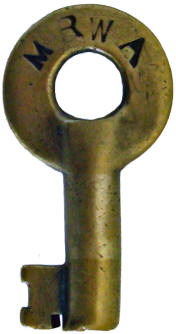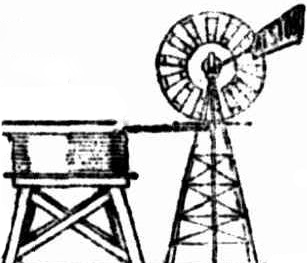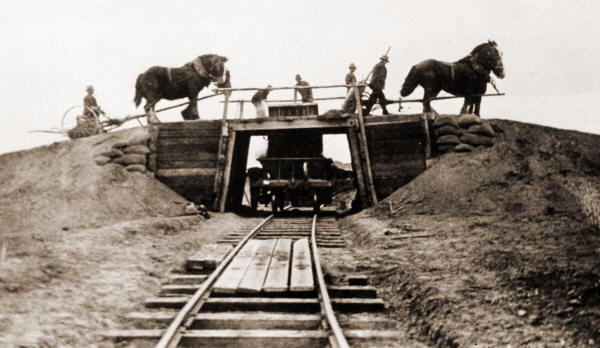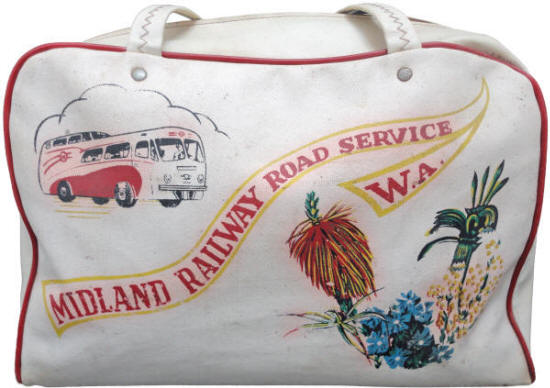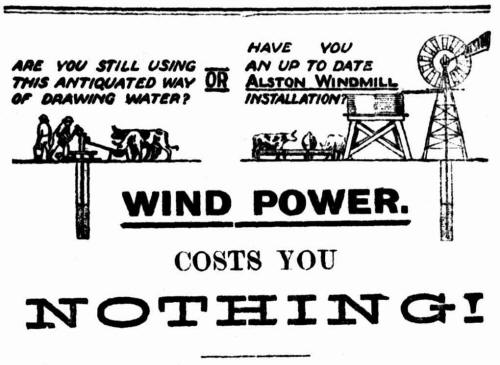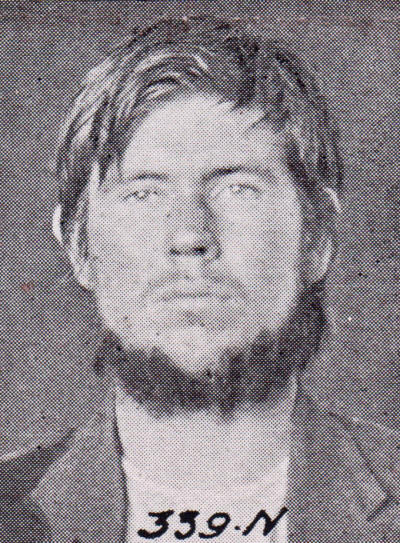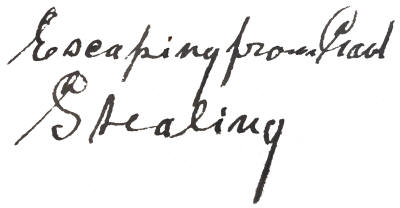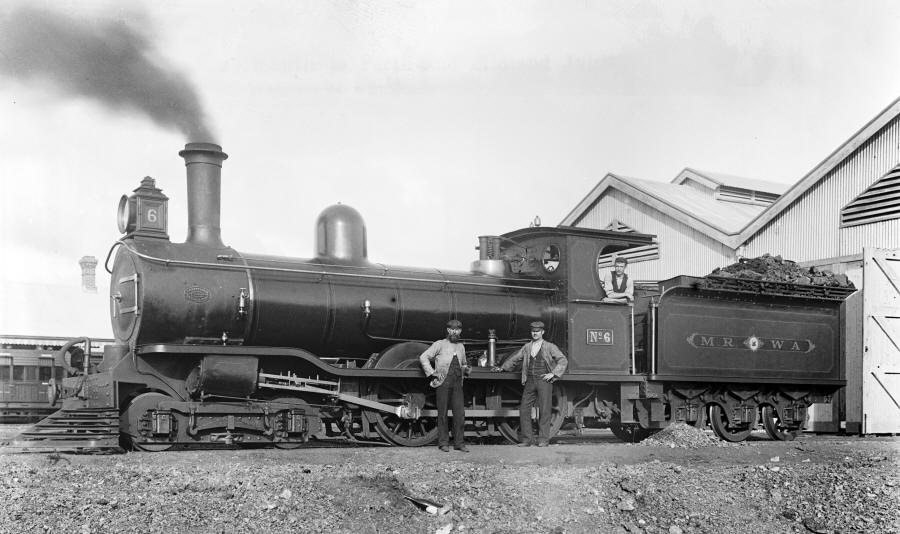
Midland Railway Company steam locomotive made in England and imported to Australia
In 1894, after eight years of construction, a new railway was completed in Western Australia. It spanned 446 kilometres from Midland Junction in Perth to Walkaway near Geraldton. Building of the railway had begun from both ends and the two reached each other at a solitary point in the bush between Carnamah and Three Springs.
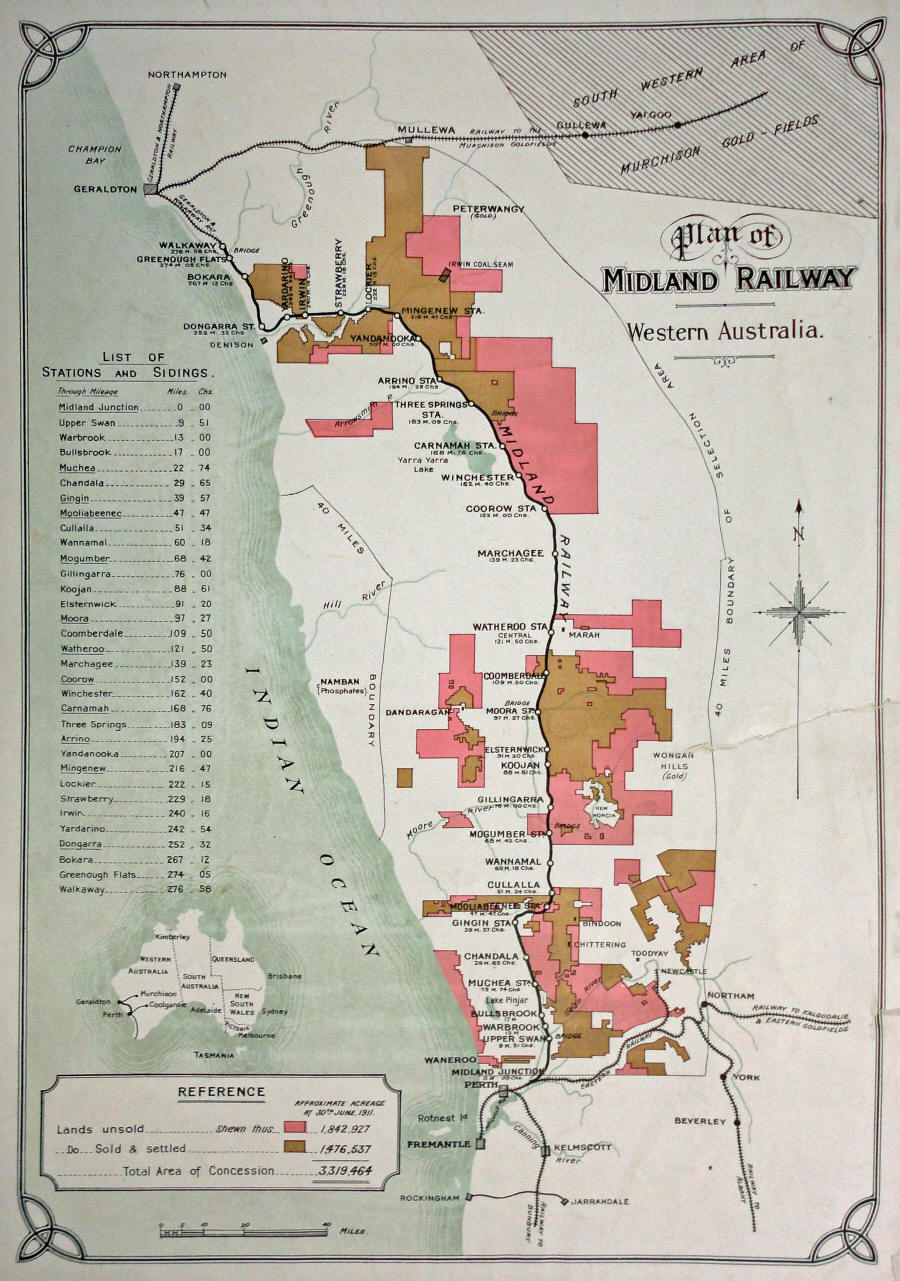
1912 map showing the route of the Midland Railway, with their land grant shaded in pink and brown
The railway was built by the privately owned Midland Railway Company which was owned and administered by its shareholders in London, England. In exchange for building the railway, the WA Government gave the company 12,000 acres of freehold land for every mile of railway. The company received a total of over three million acres (1.3 million hectares). Over the next 60 years the company sold this land as undeveloped land for farming, townsite lots and Ready-Made Farms.
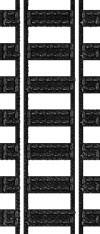
Greenough

Bookara

Dongara
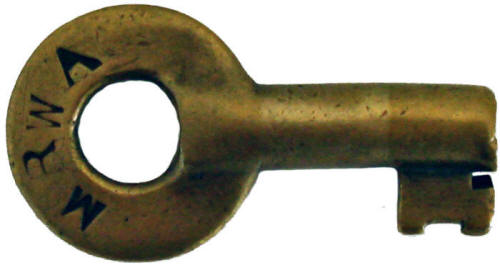
Midland Railway of Western Australia (MRWA) Z-Lock Key
Railway stations were built at towns and a few other places along the railway. In less populated areas railway sidings were established and they were often as little as a platform or shed. Stations had a stationmaster and sometimes also a night officer or clerk, and at most stations and sidings there was a ganger who was the man in charge of a team of fettlers (who worked maintaining the railway line).
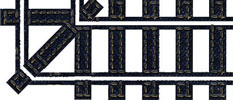





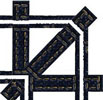
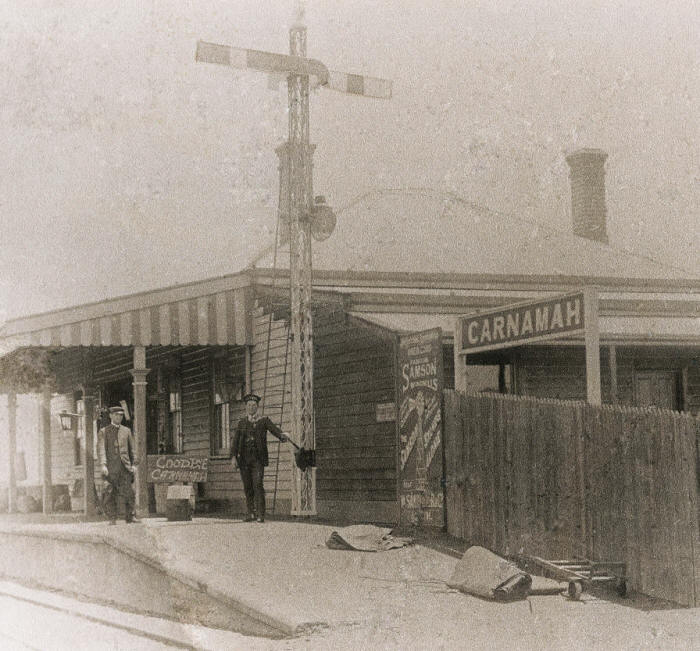
Carnamah Railway Station
Trains stopped at the Carnamah Railway Station, which was established in 1894 and named after the pastoral station of the Macpherson family. Before the railway was constructed the Macpherson's transported everything by horse-drawn wagons and herded their livestock all the way to Perth. The easier and quicker transportation offered by the railway made Carnamah a more attractive place for people to settle and establish farms. It soon led to further settlement and became the lifeblood of the district. It transported everything including people, supplies, machinery and the fruits of local farming - wheat and sheep.
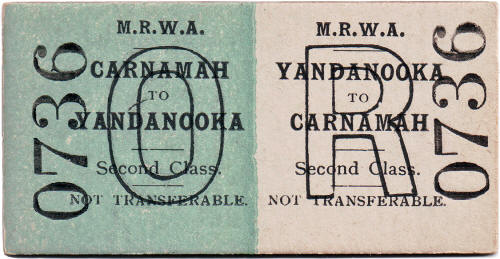
Return railway ticket from Carnamah to Yandanooka
The Midland Railway Company sold one way and return tickets for both first and second class passengers. They also sold tickets that connected with travelling on Government railways from Walkaway to Geraldton, and from Midland Junction to Perth and suburbs.
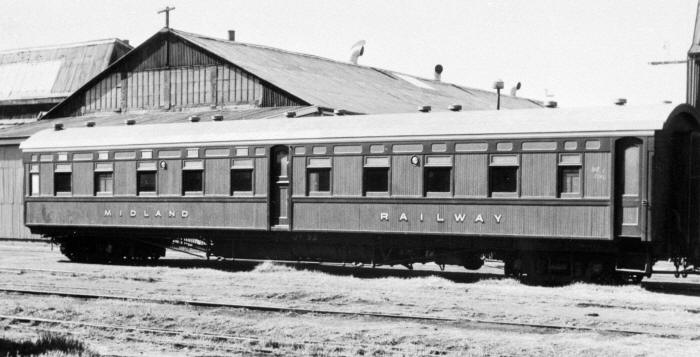
Midland Railway passenger carriage
For many years the quickest way to travel to and from Carnamah and other places was by train. In 1904 it took just over nine hours to travel between Carnamah and Midland Junction in Perth.
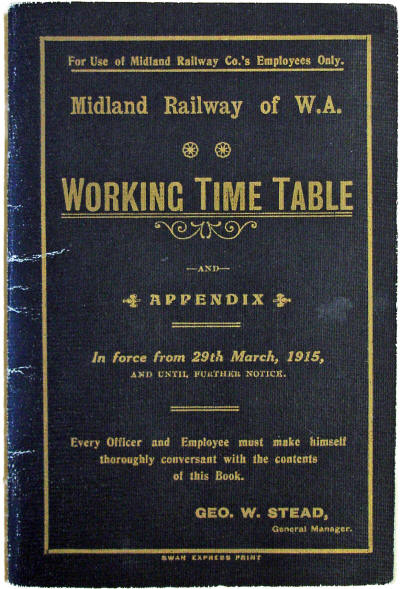
Working timetables were small booklets carried by railway staff. In addition to providing a schedule of trains, times and prices they also listed rules and what staff had to do at certain stops. There were, however, some unofficial tasks that had to be done.
In 1917 trains couldn’t depart in Three Springs until the stationmaster went out and got storekeeper Jim Whitelaw’s cow off the tracks! The cow was sometimes joined by local agent Tom Berrigan’s pony, as both animals liked scratching themselves on the trains.
Unfortunately the booklets didn't give much guidance on what to do in the event of an accident.
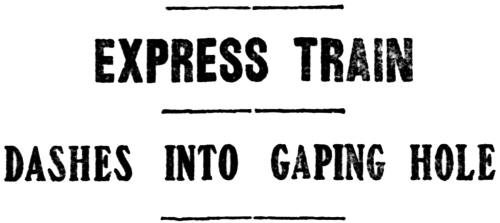
Heavy rains in 1917 caused the ground underneath a section of railway tracks near Gunyidi to wash away. When a train reached the compromised section part of the railway snapped behind the engine and pierced through a luggage carriage. Passenger carriages flew into the air and collided into each other.
"I know I
can't live, go and help the women"
- Richard C. Burges
It was 1:45 in the morning, raining, people were trapped and injured, surrounded by water, in total darkness and on the most isolated stretch of the railway. Uninjured passengers fell into the water to try and help those who were screaming and moaning for help. The body of two year old Greta Benzie of Geraldton was found floating in the floodwaters. Her mother Martha Benzie was seriously injured and died two hours later.
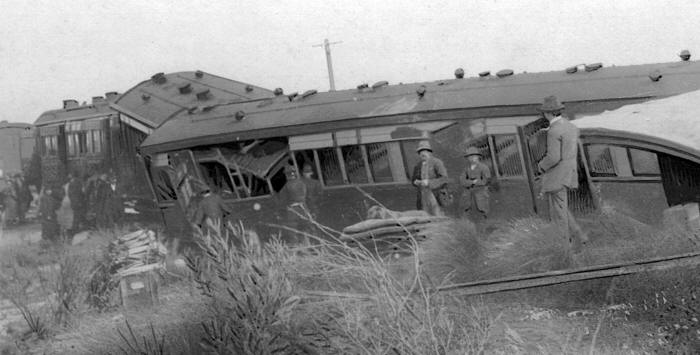
Midland Railway Disaster in 1917
Among the other twelve who were seriously injured was Richard C. Burges of Howatharra. He knew he wasn't going to survive so gallantly refused assistance so others could be treated more quickly. He died within an hour. Passengers gathered wooden bits of wreckage from the carriages and started fires so they could see to locate trapped passengers and assist the injured. After 13 hours an emergency relief train arrived from Midland Junction. The injured and stranded were then taken to Moora for medical attention and food.
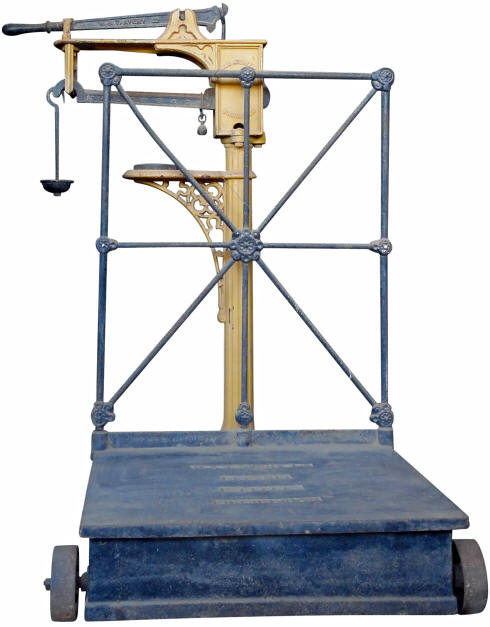
Scales were used to weigh goods to ensure trains weren't overloaded and to calculate transport charges. Prior to reliable roads all goods and supplies for shops, businesses, homes and farms were transported along the railway. This included livestock, crop fertilisers such as superphosphate and even the mail to and from each post office.
Items that arrived on the train were placed in the goods shed at the railway station. Before the building of the Carnamah Hall in 1921 most social functions and dances were held at the goods shed.

Yandanooka

Arrino

Three Springs

Prowaka

Carnamah

Winchester

Coorow

Marchagee

Gunyidi

Watheroo

Namban

Coomberdale

Moora

Elsternwick
/ Barberton

Koojan

Gillingara

Mogumber

Wannamal

Cullalla

Mooliabeenee

Gingin

Chandala

Muchea

Bullsbrook

Warbook

Upper Swan

Middle Swan

Midland Junction
(Perth suburb
of Midland)
Smith, along with a local railway fettler Harry Rodwell, were travelling from Carnamah to the 174-Mile Post on a railway tricycle when they turned a bend on the railway and were run down by an unscheduled train. The tricycle was smashed to pieces and Smith was killed instantly. Rodwell was thrown clear and survived, but with serious concussion.
The thefts were the work of a young man named Frank Thomas who’d left his father’s farm in Coorow to live the life of a bushranger. He camped in the bush and stole food and other supplies from trains, railway sidings, farms and houses. He often threw boxes of goods off moving trains then returned later on a stolen horse to go through the boxes and take what he wanted.
“To the womenfolk he was behind every bush and they felt unable to cope. The men just swore about what a pest he'd become, and passed on news of his latest depredations to Dad, the local Justice of the Peace, for relaying to Dick Honner and to Charlie Kroschel the policemen based in Three Springs in those days."
- Leo R. Parker of Winchester
Thomas flaunted his skill to escape and would steal from railway stations and sidings even when he knew police were watching to catch him! He was caught on a number of occasions but managed to escape from prison in Geraldton and from the police lock-up in Buntine. He was caught for the last time at the railway station in Carnamah in 1922.
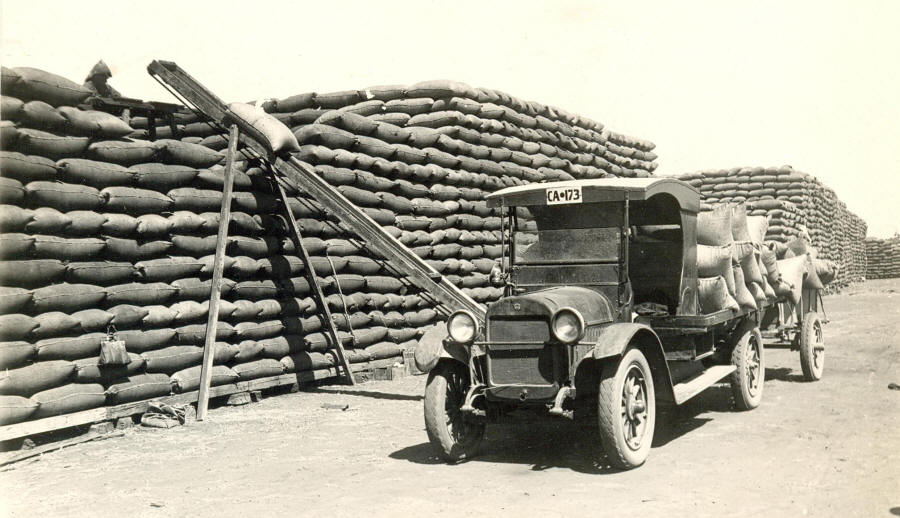
Wheat Stack at the Railway Station in Carnamah
When wheat crops were harvested the wheat was put into bags. These bags were then sewn up, carted to the railway station and stacked up awaiting transportation to Perth or Geraldton. 128,000 bags of wheat were stacked at the railway in Carnamah in 1927. Similar stacks existed at many sidings and stations along the Midland Railway until 1936 when they were replaced with Co-operative Bulk Handling wheat bins.
At various times the railway has been used for mining operations. It transported coal mined near Mingenew, copper and ballast from Arrino, talc from Three Springs and quartzite from near Moora. A spur line from Dongara has moved mineral sands mined at Eneabba to the port at Geraldton.
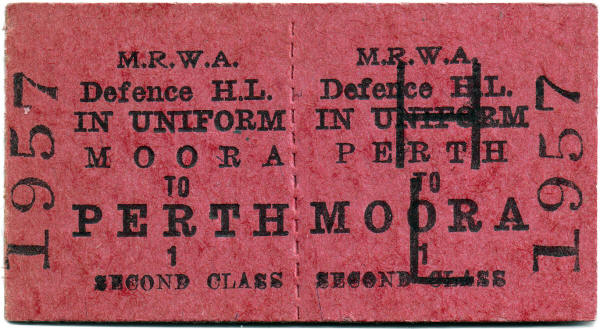
During the Second World War the railway played a role in national defence. It was used to transport soldiers to military camps at Moora and Mingenew, and also to Geraldton to defend against Japanese invasion.
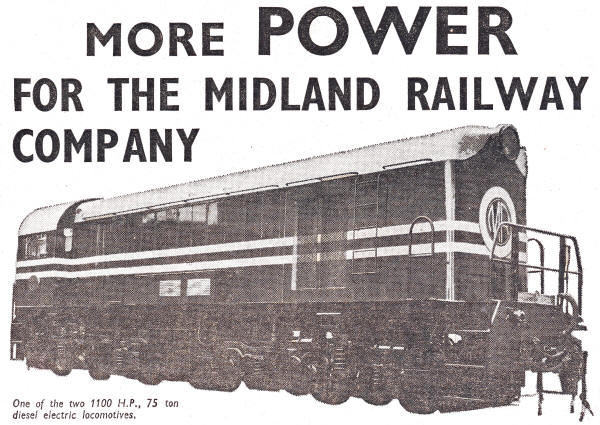
Aged steam locomotives were used along the Midland Railway until 1957 when they were replaced with more powerful diesel electric locomotives.
For a long time the railway had the monopoly on quick and efficient transportation. This began to change as roads were improved and cars and trucks became faster and more reliable.
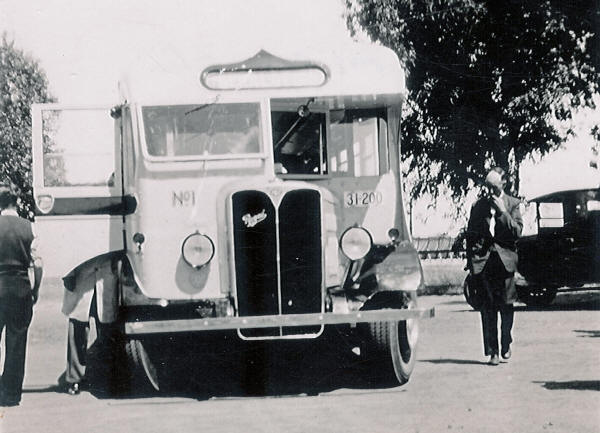
In 1946 the Midland Railway Company began a bus service between Perth and Geraldton, which they ran alongside their railway. They also used their buses to conduct wildflower tours, with Bus No. 10 having a raised back for better viewing.
Over the next 50 years freight and passenger transport services slowly moved off the tracks and onto the roads.
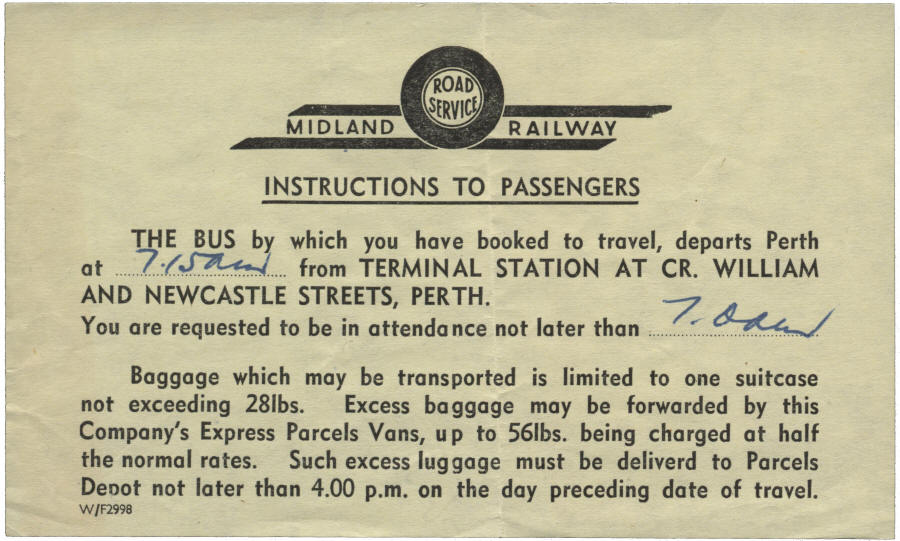
The Midland Railway remained a privately owned and operated railway until 1964 when the Midland Railway Company sold out to the WA Government. After 70 years the railway then became part of the Western Australian Government Railways (later known as Westrail).
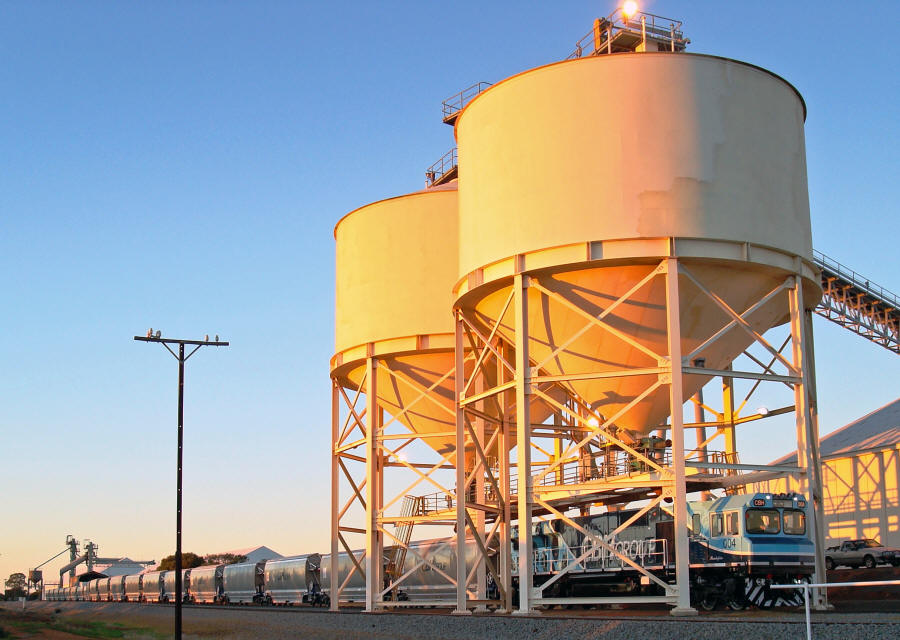
The first CBH owned train to arrive in Carnamah in 2012
Co-operative Bulk Handling (CBH) now have receival and storage facilities next to the railway in Carnamah capable of holding 338,000 tonnes of grain. Farmers deliver grain during harvest and the railway's sole use through the year is now the moving of grain to the port in Geraldton. While the railway’s purpose has greatly narrowed it endures as a vital piece of infrastructure that transports the district's biggest export. A new era for the railway began in 2012 when CBH began using their own fleet of railway locomotives and wagons.
For information on the stations and sidings along the Midland Railway, plus a collection of old railway tickets, check out our MRWA Stations & Sidings page.
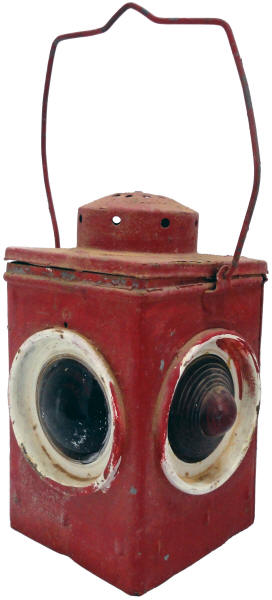
The Midland Railway was a very important service in my life as I grew up at “Koobabbie,” Coorow. Being a farm girl I was very keen on horses and my main one was called Archer. The Coorow-Waddy Forest Districts Show was a big event each year and in 1958 I decided to ride Archer into Coorow to compete in the show. Riding into Coorow was not unusual as with our stockman, Leo Allen, we occasionally drove cattle into Coorow to load on the train.
Archer and I made it safely along the South Waddy road and across the Midland Highway and were riding between a fence and the railway line, parallel to the main road, when a steam freight train appeared from Coorow. Archer was petrified as the steam engine approached so I decided to dismount before he threw me and I then tried to hold him and calm him, but to no avail. He galloped off ahead of the train leaving me to walk after him. The train slowed down and the driver called out “hop aboard and we will chase him down the line”. After about 5 kms Archer halted to “greet” Mr Ullrich’s horses in a paddock beside the line, we caught up and the driver let me off. I caught Archer and proceeded back to Coorow. Here he was yarded for the night. Leo Allen collected me and then the next day I competed in the Show. I made other trips by horse into Coorow but luckily this was the only time I met a train.
Anonymous!
When I was a girl we used to go down to Perth on the train to stay with our Nana. It was as rough as guts. Clickity clack, clickity clack, clickity clack! It was really rough and the carriages were really old. In those days the circus used to come to town each year on the train. They had special carriages for all the animals and we used to go down to see them as soon as we got out of school. If you helped them they'd sometimes give you a free pass. We never did because you had to get there very quick, but we always went to the circus anyway.
Jo Hyland
The Midland Railway Co features prominently in my family history with links to Welsh Patagonians that bought land from the company and settled in and around Round Hill and Moora in 1910 as well as family who took up land and moved to Round Hill around 1909-1910 having moved there from Boulder. Another link is my great-great grandfather James Ashworth who lived in Gingin from the 1870s, working as a bootmaker and who also worked on the railway line in Marchagee as it came through. My aunt has told me of family members waiting for food bags to be thrown to them from the train in Gingin. It was the taking up of land from the Midland Railway company that brought the two sides of my mother's paternal line together. Thank you so much for another very interesting and topical (for me) subject. My last link to MRC is that my husband did an apprenticeship as a painter 15 years after it became WAGR at the Midland Workshops.
Great work! Jo Hyland
Vida Whitehurst
I once always used to catch the train whenever going from Carnamah to Perth. You'd sometimes have to catch the train in the middle of the night and occasionally it would be hours late!
Valerie Mcooke
My Grandfather Edwin Pearce worked on the railway at Three Springs and Arrino.
It would be great to see the records re staff, working hours, wages etc.
I remember going to Perth with my mother in the train as a small girl. I recall it being dark, noisy and uncomfortable trying to sleep on the narrow bench type seats in the carriage..A trip that seamed to go on and on and on into the night. It was at night when we got onto the train at Winchester but don't recall the time when we arrived at Midland.
I also recall the thrill when we saw one of the work trolleys going along the railway line with a man or two working hard pushing the leaver to gather up speed ,we always looked along the line to make sure no trains were coming.
Jill Tilly
In 1957 I was away at boarding school and my friend and I decided that we would travel home on the sleeper train respectively to Mingenew and Coorow. We had never done this before and we wanted to experience the little bunks, one above the other, and the noisy mode of travel. We were particularly keen because we understood that it was the last sleeper train pulled by an old steam engine. Steam engines were being replaced by Diesel engines. I was dismayed when my parents unexpectedly came to Perth to take me home by car. In the end my friend and I were allowed to take the train and so we became part of the history of the Midland Railway Company. I arrived in Coorow in the small hours of the morning - I can no longer remember whether my parents met me and in any case it was only a short walk to our home and the house was never locked .
Bridie Evans
The school was on the west side of the railway so we had to cross that to get there. Luckily there were never any accidents. On the east side of the school we had our playing field, a dirt road, and then the railway line with a big culvert under it. Often a train would come through at lunch time so sometimes we would run over & get in the culvert when we heard the train coming. It was good fun but must have given the poor engine driver heart failure!
When Worths Circus came to town it was always by train & they would tether their elephants in the station yard which was a short cut for us. It was great watching them.
There was always a Saturday train about 7pm from Perth. Many people would go up to see it come in and often they had cases of stone fruit to pick up. It also brought the mail and the postmaster and telephonist on duty would sort it as the farmers were all in town. We had Thursday afternoon closing then and the shops were open all day on Saturday. The fruit shop would quickly open their cases of fruit too and do a good trade.
When I went to Perth by train in later years, about 1959, I took three daughters, the youngest only three months old. Being January and hot we had the window open and so we got covered in quite a bit of soot from the coal fired engine. There was a toilet in each carriage, but as soon as the lid was lifted we saw the ground going past underneath – a bit frightening for the girls.
My sons and their friends would often put a halfpenny on the line hoping to get it squashed into a penny by the train!
Aidan Whitehurst
I remember fondly the days of my youth spent watching the train movements across from my house in Carnamah. I, like so many young boys, dreamt of becoming a train driver when I grew older, and having the rail line located across the street from me fuelled my passion for the railways.
Back then the trains were more frequent, and varied. There were the seemingly endless grain carriages rolling through on their way to the CBH ‘wheat bin’, as well as the odd talc train with boxed carriages draped in red and yellow tarps on their way to Fremantle from Three Springs. Occasionally some flat bed carriages would be towed through town by a single bright orange engine with bright blue ‘Westrail’ logos on the side.
Before the wheels of progress turned from the rail to the road, I used to enjoy watching the BP tankers back into the fuel depot on the edge of town; sometimes sneaking over the road to have a closer look when my mother wasn't at home. I recall one Saturday morning my older brother thought it would be fun to jump onto one of the carriages as the train backed slowly into the depot. This didn't amuse the engineer, who had been watching our every move from the back of the train. He shouted out at us to get off and informed us that he was going to tell our parents. In hindsight I don’t think he knew who we were, let alone our parents, but nonetheless we ran home as fast as we could and decided it best to just watch from across the road for a while.
I remember spending summer holidays at my Nanna’s house, who also lived across from the railway on the other side of town, with my cousin. As a cheap thrill we would hang on to the rails that were bolted to a small bridge that ran over a creek as the wheat trains would come past. The drivers would yell at us as they went past, what exactly I don’t know as the engines were so loud, but I can assume it wasn't how’s your day been? Upon our return back to our Nanna's house we would receive another ear bashing, as she had witnessed the whole thing. Admittedly it wasn't a very safe thing to do, but it was damn good fun.
The highlight of the year though was when the Hotham Valley tourist railway would bring their passenger trains through town being pulled by the most majestic, and extremely well-kept, steam engines. We would go up to the station and wait for their arrival, sometimes two hours beforehand. I still remember goose bumps rising from my skin as I saw the steam and smoke in the distance signalling their approach. For the railway enthusiast there is nothing more beautiful, more elegant and more exciting than watching an old steam engine as it rolls thundering along the rails. It is akin to experiencing the height of feminine beauty from a bygone era, the style of Grace Kelly mixed with the flamboyance of Katharine Hepburn.
One day I was allowed to ride the train up to Three Springs with some friends, and I couldn't stop thinking, “Why do people drive cars everywhere?”
Sadly the trains don’t run through town so much anymore, and the only ones I ever got to drive fit in the palm of my hand, but I will always cherish those memories of my simple boyish fascination with those grand old machines; after all road trucks aren't that fascinating.
Wendy Le Get (nee Rudduck)
The Midland Railway has always been very much a part of my family’s history as it was through a contact with Midland Railway that my Grandfather, Samuel Burton Rudduck, established his farm at “Koobabbie”, Coorow. Under the agreement between the company and the Government, the company could select a tract of land within 40 miles (64 Kms) on either side of the proposed line. Sam heard that the surveyor for the Midland Railway Company, Mr Nunn, had seen a good pocket of land that was not worth including in the company’s selection. It was separated from the line by an area of salt lake system which would have to be included if the good pocket was taken. Sam saw the opportunity and in 1906 exercised the option to select before survey, which then existed.
At this stage he was working in Perth and continued to do so for the next six years to finance development of the farm. On Friday nights he would catch the train to Coorow and at about the mid-point between Marchagee and Coorow the train would slow down to allow him to get off. He would then walk the twelve miles (19 Kms) across the salt lakes to the farm and supervise the clearing and fencing in progress. On his return journey he would again walk across the lakes and signal the train with a lantern for it to pick him up. History does not record how often he did this, but it was quite regularly.
Ross Croft
I lived with my family in Coorow just across from the railway station. I am not sure how it came about but I got to know one of the locomotive drivers, Bob Thompson, and regularly used to ride on the footplate of the old steam loco's when they were shunting in the station yards. On one occasion during the school holidays I travelled from Coorow to Mingenew on the footplate of the loco; quite an adventure for a 9 year old. When the diesel locomotives replaced steam, the railway lost some of romance associated with rail travel the roar of a diesel didn't seem to have the same appeal as the hiss of escaping steam. The Midland Railway certainly played an important part in the development of the wheat industry throughout the Midlands and while the importance has diminished, it is pleasing to see that the rail is recognised as still being the most efficient way to move the large quantities of grain produced in the area between Coorow and Mingenew.
Betty Brennan (nee Mulligan)
There was no railway platform at Winchester so you climbed up and down the side of the trains. There was a goods shed where all the stuff for Mulligan’s shop at Winchester was left like groceries, big bags of onions, crates of spuds, mostly all in wooden boxes. All of Dad's boxes were marked WGM WCH which were Dad's initials and for Winchester. Bread came from the bakery at Moora twice a week. I'm not sure why it didn't come from Carnamah.
Out at Billeroo there was a teacher Arthur Jackson who was in an accident. They needed a new teacher so they sent one up. He got off down the side of the train into pitch darkness but saw the little goods shed so climbed in there and slept with the mail bags until morning. Then when Dad went to get the mail he found him there. He had breakfast with us and then someone came and got him in a horse and cart to take him out to Billeroo.
Vera Simpson whose father worked for the railway at Winchester as a ganger loved to go to the dances in Carnamah so she would get hold of one of the railway trolleys and she'd pump all the way to Carnamah, go to the dance, and pump all the way back.
I do remember going to Perth. Sometimes we used to go on the train for two weeks holiday in Cottesloe. Dad would drive us and other times we'd be sent on the train. We have to climb up the side of the train as it came in about two in the morning. When we'd see the black boys or grass trees we'd know we were getting closer to Perth. At Midland we’d change to a government train and at Perth station our aunty would be there to collect us.
Keeva Verschoor
I’ve always regretted the demolition of the old weatherboard station master’s house, no doubt an executive decision made with best intentions, because its disappearance has left a yawning hole at the western end of MacPherson Street. The house and goods shed were an integral part of the town and had sat there comfortably for years on that slight Incline and circular driveway behind the War Memorial. Their very positioning signified the importance of the Midland Railway to Carnamah. What an excellent Midland Railway museum it could have made. The front of the house abutted the platform and I’ve often wondered how the station masters tolerated the noise of locomotives and wagons passing by the front door of their house, possibly even the bedrooms, day and night.
My first journey of any kind ever was on the passenger train service from Perth when Mum brought me home (I was born in October 1945) as a newborn, and I can just remember travelling down to Perth on the train and being told in no uncertain terms not to open a certain door, else I could fall out. My last journey as a passenger was in September 1964 when I rather fancifully decided to travel to Carnamah on a sleeper though it meant being woken up at 2.00am to get off. I doubt that there was a dining car, and I think the passenger service was discontinued not much longer after that.
The railway sounds and smells were a backdrop to town life; the shunting of the locos and clanging as wagons were coupled up, the whistles, the whiff of coal smoke, were ever present and taken in subconsciously, until suddenly, sadly, the big, black, sinister, hissing monsters were gone and were replaced by maroon coloured locos (I imagine there must be one or two in the Railway Museum) in 1958 or thereabouts, after which came the purring of Diesel engines and the sound of progress. No more fires trackside started by cinders and a different sounding whistle.
Ian Forrester told us once that his father, “J K”, always took bottles of beer to the Station Master at Christmastime a token of the importance of the position. The Midland Railway was the lifeline.
Helen Green (nee Rowland)
Audrey Dewar, Rica Diamond, Effie Dallimore and I used to catch the train from Carnamah up to Geraldton for school.
Tony Allender
As I was only 6 years old at the time I can’t remember an awful lot about the railway except that as a typical 6 year old I loved it. We lived in the “Shell” house in Gardiner Street across from the railway. I do remember waiting out in the front yard with Mum and Dad to see the first diesel train. I remember that it was raining and we stood there in the rain watching the train rumble through on its way north.
As my Dad was the Shell rep in Moora, the biggest impact the diesel train had on us was that it could shunt the fuel tankers into the depot. The steam trains were not allowed in the depot yard as they contained fire, and as such had to back the tankers over with flat top carriages in between the engine and the tankers. The train would then have to wait in the road until the full tankers could be uncoupled and empty tankers coupled manually. As a result Gardiner Street could be blocked for an hour or so.
I can also remember as child, I and the other kids in Moora would put pennies on the track for the train to run over and flatten. I think kids all over the world did this. In the mid to late 50’s, the north bound train derailed in the centre of Moora town, where we had put the pennies. We all thought we had caused the derailment and were the best behaved kids in WA – for a least a couple of days.
Hope the above is of interest to you.
Ian Macpherson
My parents ran the Watheroo Railway Refreshment Rooms between 1942-1945. I was only 3-4 years old when we moved to Watheroo from Mingenew.
Just a small story that happened to me as a child. The troop trains would stop here for refreshments on the way down from Geraldton to Perth. This particular night my sister and I were put to bed in our parents room, a soldier from one of the troop trains came into the bedroom saying hello to my sister and I and proceeded to take items from the dressing table, one of the items was a photo of my sister and I. As the soldier was never identified my parents always wondered why the photo was taken.
I think all trains stopped at Watheroo as they had a large coal chute and water column for the Loco's opposite the station. There was a derailment that was quite an event for the area, a hell of a lot of people turned up sightseeing, the loco had disconnected to load up with coal and water when it jumped the track. Most trains had one or two passenger carriages hooked on, not many passengers, but I can remember the troop trains quite vividly, when I say not many passengers, these trains usually came through late at night so I would not see if many people got off.
The food available at the time would not have been of a great variety as rationing was set up during wartime. I don't know what food was available but I can remember the Station Master would bring in now and again a large bag of parrots that he trapped, mainly 28's which my mother would use in stews etc. He also had a large vegetable garden at his house and would supply these to Mum I suppose at a price, his surname was Mortimer and in later years he was transferred to Moora. Dad had a couple of cows which he milked for the refreshment rooms and I can see him using a ging ( a slingshot ) for the dogs that came around, and boy! was he a good shot as I can still see these dogs yelping as they belted up the road.
Elsie Waghorn
My maternal Grandfather John Angel and his brothers worked all their lives for the Midland Railway. My mother Ivy Evelyn Fiebig (Angel) was born at Yardarino in 1902, the eldest of seven and the family moved down the line gradually as far as Watheroo spending time also in Coomberdale, Irwin and others before retiring to Carnamah as my dad Alan Fiebig, a policeman was then stationed there.
The houses I remember were built of railway sleepers lined with wheat bags sewn together by hand. Even then it made me realise they had it very tough. In Watheroo the family lived next to the town reserve, where they grazed their cow and other animals. They grew all the food for their large family.
In 1943 and 1944 my brother Brian Alan Fiebig and I travelled by Midland Railway train to Mogumber, to attend boarding schools at New Norcia - St Gertrude's and St Ildephonsus. We were then living in Perenjori and Dad drove us over to Carnamah or Three Springs to catch the train. The brothers then met the train and we travelled on the back of an open truck, in the middle of the night on an unsealed road to New Norcia!! HORRIFIED now but did not seem so bad at the time. We did not expect too much those days.
Tracy Willet
I have such wonderful memories of playing at the old railway station [in Carnamah] and loved that old building so much….. I wanted to cry when I found out it was to go. And also the house connected to it where one of my best friends lived (her dad, Mr Jones must have been the station master at the time).
Gordon Campbell
Yandanooka Raillway Station consisted of one central main line and two shunting lines. One shunting line was for CBH grain loading on the north side. The shunting line was on the south side of the main line and served as a goods line which went past a loading ramp, goods shed, cattle and sheep loading ramps, down to a length runner camp where the length runner could lift his trolley onto a short line. The unloading ramp was used for all manner of items i.e. tractors, machinery, wool etc being railed to or from Yandanooka.
The goods shed was for Post Office mail, perishables, goods etc. The area between the goods shed and the sheep and cattle loading races was used for road trucks to back up to unload fertiliser which came in 180 lb. hessian bags. It was wheeled on bag trolleys from rail wagons to road trucks. The sheep and cattle yards were fairly extensive as in the earlier years, quite large numbers were railed from Yandanooka. The length runners hut was accommodation for 1&2 men, whose job it was to ride on a runners trolley, the early ones were operated by hand and later fitted with engines. It was the length runner's job (he was completely open to the elements) to travel along the line listening for and looking for any repairs needed on the railway line.
Services out of Yandanooka
- Rail passenger services East Perth and Walkaway
- In earlier years milk and cream were sent by train, as well as turkeys and other poultry
- Cattle and sheep
- Produce - grain, hay, chaff, wool
Services into Yandanooka
- Fertiliser
- Machinery - parts
- Sheep & cattle
- Parcels, including bread from the baker in Mingenew on Tuesday and Friday to the local store
- Green groceries etc for the local store
Memories of the railway:
Hearing the train on a damp morning trying to get up Lynch's Hill south of Yandanooka. On a foggy morning after stopping to unload at Yandanooka it took several attempts which entailed backing down the line for two or three kilometres and getting up speed coming through Yandanooka to get up the hill.
The train stopping for a break on Sunday afternoon for the crew to watch the local football match from the locomotive.
Loading cattle and sheep on cold frosty mornings at 6am in time for the train to Midland Junction
The noise and smell of a steam locomotive had something nostalgic about it. A trip by train to Perth - left Yandanooka about 10.30pm, arrived at Midland Junction anything up to 12 hours later. The train was a way of children at boarding schools to come home for holidays.
Mrs Jean West
My g-grandfather, HENRY MOSES, lived Midland Junction, was a train driver c.1899-1910.
Suzanne Marsh
Neither mum or dad ever really discussed Winchester let alone the railway.
However, mum did relate just one story to me. It was when she was travelling to Tenindewa. I don't know what part of the trip it was. Is this still part of the Midland Railway? [ it isn't, but how could we not include this great railway story! ] Tenindewa was her first teaching placement and it was the first week of September 1927. She was travelling alone on a steam train in one of the old fashioned 'dog boxes'. At one point the train just stopped in the middle of no-where and the fireman and driver headed off into the bush. The guard told them that the men had gone to catch a "bush turkey"… a malley fowl. The train and its passengers simply waited for their return. Apparently they were successful. The trip was then resumed. I'm sure mum said they were there for quite some time.
While on the same journey, and I'm fairly sure this was the section between Geraldton and Mullawa, the train pulled into one of the sidings. It must have been a Friday or Saturday night as there was a well patronised pub across from the siding. The guard was concerned for mum's safety as she was only 19. He came and locked her into the dog box for her safety which also meant she couldn't get out!
Mary Clews
Ian Straiton, my late husband, travelled up and down to Perth, collected and sent from the Winchester siding. One incident I do remember him reporting was that he was standing at the siding one day and just stepped aside when a train went through without stopping but somebody shoved a huge parcel out of a van which landed fair and square into the siding. ESP or something made him step out of the way in time or he would have been killed.
Our house was a Midland Railway house and the beams were 28ft long because it was an economical size for owners of railways to transport wood.
Susan Aguire
I remember that my dad had a Midlands railway bag like the one on these pages. I presume that he got it from his dad, my grandfather, because he worked for the railway up in Carnamah in about 1926-1927.
Wayne Bentley
As a young boy living on a farm just out of Carnamah, where the railway line and main highway passed by the front gate, I always found the old steam trains fascinating as they thrust their way past our area. There was a railway crossing of sorts nearby and you could hear the whistle blow as they approach that crossing quite often. Of course my father was not as impressed as I was during the summer months when the crop had ripened and was almost ready to harvest. Fortunately these steam engines were fitted with spark arrestors, however if not cleaned and regularly maintained, sparks would still omit from the stack and can be quite clearly seen at night as the trains passed by.
One of the things that I and particularly other young boys really enjoyed were the Sundays when our parents played tennis at the Winchester tennis club. As we weren’t quite old enough to get involved in the tennis itself it was an opportunity for us to get together and amuse ourselves in the bushland around the tennis courts and over the highway where the Winchester wheat bins stood. The highlight of these days was when the Sunday afternoon steam train passed through Winchester, but particularly as most occasions it had to stop and shunt for a short time to disconnect carriages that were being left at Winchester and connect those which were being collected after being emptied previously. I am sure that the current Occupational Health and Safety people would be quite horrified at these young boys so close to the trains, crossing the railway line and getting involved with this activity. On one particular occasion when there was only two boys there, one being myself and the other I will not name as I don’t wish to embarrass him, the engine driver, who had probably seen us on numerous occasions previously, decided to give us a treat so he stopped the train and invited us to get on board with him while they were doing the shunting. What excitement this created and we both jumped on board as quick as we could scramble up the ladder into the steam engines cabin. The shunting process then commenced and back and forward we went a few times, until it appeared that there were some empty carriages to hook onto the rear of the train. To do this the engine had to travel out of the siding a reasonable distance to clear the last points before returning on the different section of rail. Unfortunately the boy that was with me thought that the shunting had been completed and that we were now off from Winchester and heading for Coorow next stop. Well I can assure you there was such a howl omitting from this young fellow that the engine driver took the only action he could think of, and that was to stop the train and allow these two young fellows to get off. One feeling great relief because he wasn’t going to end up in Coorow, the other being extremely disappointed that our special ride on the steam train ended prematurely. I guess it may not be a wonder that the boys didn’t get offered a ride on the train engines again in the future.
One of my earlier memories of Midland railways was I believe from around 1950 or 51. Obviously the seasons hadn’t been too bad on the farm and my father purchased a brand new Fordson Major petrol/kerosene tractor (I think it was the E27N model). Well of course this had to arrive in Carnamah somehow and in this case it had been loaded into a Midland Railway freight carriage. Of course that would be fine except that it appears they used a crane in which to lift this tractor over into the railway carriage. I’m sure many of the older generation and farmers will remember how so many of those carriages had pretty high sides and had one doorway in the centre on each side of the carriage. Well that should not have been a problem, there was a crane on the siding in Carnamah but of course this was hand operated and on closer inspection was found not capable of lifting the weight of this new tractor. Consequently, due to the length of the tractor and the door being in the middle of the carriage, it appeared this tractor was going to have to remain in the carriage and perhaps be sent off to somewhere else where a suitable crane was available to lift it over the sides of the carriage. As you can imagine, there were a few words murmured that perhaps at my age I shouldn’t have understood, but after a period of contemplation and pacing out the available space it was decided there may be a small chance that the tractor could be maneuvered enough to get it out the central doorway. Now bearing in mind that these tractors did not have power steering and unless moving, turning the front wheels was a fairly tough job at the best of times and took considerable muscle power, the process began. From my recollections this maneuvering continued on for an hour and a half or more, even incorporating the use of a hand operated bottle jack that could lift the front of the tractor and then be pushed sideways to get the front wheels in position to move outside the carriage, bumping over the space between the carriage and the platform back and forward numerous times, each time allowing the rear of the tractor to be repositioned an inch or two each time, until eventually the task that was originally thought to be impossible was achieved. This is all done using a gallon of petrol poured in to the fuel tank that were supposed to get it back to the farm, which fortunately was only a 4 mile trip to the farm shed. Having extricated this tractor from the carriage in which it was a captive, this shiny new Fordson Major tractor with 27 horsepower, three forward gears and one reverse, headed off at a top speed of about 6 miles an hour to its new home on Jack Bentley’s farm, where it remained for the rest of its working days and where today, bits and pieces of it may still be seen laying around.
AEnone McRae-Clift
While not exactly in the area of this article, my maternal Grandfather, Henry Norman Townsend, worked at the Midland Junction Railway yards around the late 1890's-1900's. He was a construction engineer, so I have no idea just what he would have been doing there, as it wouldn't have been work on locomotives. I still have two metal buttons which were obviously cuff or shirt buttons from one of his shirts, and they are inscribed with the W.A. Government Railways logo. In later life, he moved back to the East Coast and was Overseer at Burrinjuck Dam in the 1920's.
Pat Shaw
This is wonderful. Congratulations. Great job.
Betty Plunkett
The Three Springs railway station was built up and when we were children I remember finding an opening and crawling under the building – why & who with I don’t remember! I think someone came along eventually told us to come out. When [my husband] Maurie was a child living in Carnamah Mr House was the Station Master and Maurie and Desi House the son played in the Railway yard on the south side of the War Memorial.
It was my grandfather C.F. Thomas that organised the building of the fenced garden that stood for many years between the road & the railway station in Three Springs. I can still see it in my mind. He was probably on the Shire council at the time or he could have done the job himself.
I travelled on the train in 1945 & other occasions going to boarding school. Eventually the bus took over. Also as a child I can remember waiting in the night for the train either to see my brother Arthur off to the war or returning, they were sad times. It is quite vivid in my memory.
Stephen Frost
My mother (Dorothy Frost, nee McSwain) has a few recollections of Midland Railway. She doesn’t think they’re very interesting but I got a kick out of hearing them. They certainly show how times have changed!
1. Mum was born in late 20s. In the late 1930s and early 1940s, her family (her parents and four sisters) went by train to Perth each year. These were big trips so she recalls them quite clearly. One thing that stayed in her mind were the fettlers stationed along the railway track. In those days they were stuck out in the middle of nowhere (even though today it might only be a 30-minute drive from Carnamah to their camps). The fettler’s families used to live with them, and when the trains went past the children used to yell out, “Papers! Papers!” They wanted newspapers because this was the only way they could keep up with what happened in the outside world. Mum’s mother, knowing this would happen, collected newspapers and magazines for several months before the trip, bundled them up, and then threw them out the window as they went past.
2. On one of these trips, a cinder lodged itself upon one of Mum’s eyelids. Because it was red hot, it burned into her skin and they couldn’t dig it out. Upon reaching Midland Junction, they went to a doctor who removed it. She had to wear an eye patch for some time. She said it hurt “like hell”.
3. She remembers also that drinking water was provided on the train by way of water bags hanging on the outside of carriages. Passengers would lean out the window to get a drink.
4. She recalls farmers bringing bagged wheat to Prowaka Siding (a name I’d never heard until this morning, but looked at your Midland Railway exhibit and found it).
5. When the train stopped, they used to all rush off to buy something to eat (usually a pie). She thinks this happened at Gingin or Muchea. She said they had to hurry for fear of being left behind.
6. Much later (as an adult – so I guess sometime in the 1960s), Mum had to have a bone in her little toe removed. She needed morphine as a painkiller after the operation, but the doctor in Three Springs forgot to give it to her when she left the hospital. So he sent a large bottle down by train. It was deposited in the small open shed at Marchagee Siding where my father later collected it. I wonder if such a delivery could be made today.
The world is a different place. Prowaka is nothing now but a memory. Some of the children who yelled for papers to be thrown from passing trains may have eventually used - and still be using - the internet (what a tremendous change in one lifetime).
Fred Otte
It was dawn of the 29th July, 1929 when we arrived in Midland Junction... I decided I would go to Carnamah... I travelled all night till three in the morning on one of the most uncomfortable train journeys in the world. It was slow and bumpy. The carriages were antiquated with box-like compartments and it seemed like they might fall apart at any moment. We were crowded like sardines in a tin, and the windows could not be opened because of cinders from the engine. At three in the morning I de-trained at Carnamah in company with a friendly commercial traveller. Together we stumbled in dim moonlight from the siding to the hotel at the other side of town.
Phil Kemp
I worked for John Bowman in Carnamah in 1940. I can remember carting the super from the railway station with an old Morris truck which had no bloody brakes. You used to use the gears to pull her up! She was a good vehicle out in the paddock picking up the Mallee roots. You’d just let her go along on her own and you’d trial behind and throw them on the back.
I caught a train to Perth, it was quite a long trip. I was wanting to join up in the navy and when I got to Perth they said I should have gone to Geraldton so I finished up in the army!
Lee Evans
Recollections from Yandanooka, 1940s
One evening each week (it might have been on Wednesdays), we would walk down from the School House to the Yandanooka Siding, to meet the train coming up from Perth. The mail bag and any parcels or packages would be taken to the undercover area. Mr Joe Campbell (storekeeper) or his son Mal would drive their utility over on some occasions, and I remember watching their progress to make sure they beat the train as it approached the crossing. It seemed to be a close shave sometimes.
On other occasions, Dad (Neil Grosvenor) would carry the mailbag across to the store, and we would wait while Joe or his wife Ethel sorted the mail, in case there was something for us or the school. I think there was the occasional delivery of meat for us (from the butcher at Three Springs) or a box of fruit and vegies from further south.
Length-runners used to camp in the quarters not far from the siding. Dusty Rhodes, Wally Cromwell and Jimmy Thompson (ex-jockey) were names I remember. They would visit our home sometimes, or Dad would call in to their quarters for a yarn. Their camp was very small, with very sparse surroundings.
I remember one occasion when one of my sisters suggested that we could put some pennies on the rail lines before a goods train came through. Unfortunately, one of the length-runners returned on his trolley ahead of the train (I think it was Mr Rhodes), and he was very cross as the wheels clattered over the pennies. They were beautifully flat, however, and we scampered off with our treasures, as the length-runner yelled that we could have derailed the train doing what we did.
We made a number of journeys down to the city or up to Geraldton, travelling in single-door carriages. I remember the plush leather seats, and the metal luggage racks high above the head rests. We were reminded not to put our heads out the window but it was very tempting, and many a tear was shed when dust from the train's funnel would blow into our eyes. I know coal-fired trains pollute the atmosphere but the sound of a steam train (as featured in old-time movies) brings back happy memories of our Yandanooka days.
From The Western Mail newspaper of 15 October 1936
"It was some time before Three Springs was important enough for the train to be stopped, and letters had to be tied to a bent sapling and [were] taken by the guard of the train as it passed through."
Gil Rooke
To the south of the station was the goods yard. Somewhere near the corner of McPherson St and Yarra St (near the current roadhouse) was the small goods shed. Parcels and other goods that could be offloaded from the goods wagons, were placed in here for the owners to collect. It was locked overnight. I think it was probably there for many years, because my father told me a story of some of his mates in town inviting him to a drinking session in the bush just out of town. It must have been in the late 1920s. They had managed to spirit away a keg of beer from the shed and intended to enjoy themselves. Those were the days when you could get ‘plastered’ and not have to worry. All your friends had to do was dump you in the sulky or wagon and release the horse, who knew exactly how to get home. You then were woken by your father at 6am and told to get the horses fed . Anyway, when they gathered in the bush and someone produced the keg , it was duly opened and drinks were poured. Uggggh! It was totally salty. Inside the barrel was filled with sausages that had been preserved in brine. Wrong keg!
At the station, the single railway line divided into two. The train consisted of the engine followed by a number of goods wagons, the passenger carriages and a guards van. The train stopped with the carriages alongside of the roofed part of the platform. The train was then decoupled just behind the goods wagons for Carnamah. The engine could then use the second line to move the now shortened train past the carriages to the goods yard, which was an extensive area involving several branch lines including the one for the goods shed. The bit that interested me was the way that they could ‘fly shunt’ a string of wagons. The required wagons were decoupled from the train, which would then give the necessary wagons a good shove. Station hands then positioned themselves at appropriate points. On the guards instructions, they threw the points as the wagons went passed. Then when the selected wagon(s) had gone down a side line, they threw the points back again to allow the rest of the wagons to go onto the next set of points, where another helper repeated the points switching. I thought it was ever so neat. Guess which 6 year old wanted to be a train driver when he grew up.
From my memory, there was always a large grain bin on the side of this complex. I see that it was built the year I was born (1936). Now days, the wheat bins are all on the north side. Before the bin was installed, they used to drive the horse drawn wagons alongside huge stacks of bagged wheat. These three bushel bags of wheat were carried on men’s shoulders onto (or off) stacks. This lead to the inevitable competition of, who could carry the greatest number of bags and who could load the greatest number of bags in an hour. Remember, a bushel of wheat weighs about 65 lbs (30 kg). That is, each bag weighed almost 200 lbs. I seem to remember that dad said that the record was 3 bags for each trip. That is 600lbs (270kg). Even when I was in my late teens, as a weighbridge attendant, I could only drag a 3 bushel bag across a truck. And my bags, being unsown, were always under filled to stop spillage. Some of those farm workers were strong.
To the right of the station was the tennis club. A bit further north was where the circus stayed when they came to town. They had their own wagons, containing elephants, horses, lions and other animals. I imagine that these wagons were also the overnight accommodation for these animals and so there must have been some track in there.
In the time when our soldiers had come back from Egypt they moved up the west coast ready to defend it. There was a constant stream of army convoys, firstly moving north. Then, when the scorched earth policy was decided upon, moving back south again. Many of these soldiers managed head south on leave in Perth. Every train had a significant number of soldiers on board and without tickets. Between stations, the guard was walking along the east side of the train checking all the compartments. At the same time a large number of soldiers were hanging onto the west side of the train, all shuffling in a squatting posture, to keep their heads below window level. The other ploy was to squeeze as many soldiers as possible into the small toilet, along with one of the lady passengers, leaving her ticket for one of the fare paying passengers to show to the guard, explaining that the lady was indisposed. When the train approached Midland Junction the train went very slowly for several hundred yards. When we arrived at Midland, there were very few soldiers on board.
The speed of the train was normally about 30 miles per hour (50 km/h). I remember, one time when we drove down to Perth, being impressed that our car could easily overtake the train.
I also remember the tea rooms at Gingin (I think it was Gingin, as Muchea was too close to Midland to be effective). When the train blew its whistle, the cafeteria emptied with a mad rush of people. Then there were always the stragglers who just made it as the train was moving out of the station. I saw a similar arrangement on the old Ghan railway from Alice Springs to Adelaide. Here, the watering hole was a pub across a barbed wire fence from the train. The panic of those whose clothes got caught in the barbed wire made interesting viewing.
Margaret Thomas
My Dad Bill Foskett worked in the MR his whole working life, we travelled up the track where he was a station master ... Muchea, Watheroo and Carnamah, I lived in the station houses in theses three towns until I was about 11 years old. We then moved to Midland where he worked in the main office in Midland. He was there until the MR was taken over by the Government Railway, he was there when he died in 1964.
Arthur Todd
As a young Station Relief Officer (SRO) with the then WAGR based in Geraldton I would relieve Assistant Station Master Cliff Humble in Carnamah when he went on leave. The first time I was there in the early 70s the old MR railway station had been demolished and a new station building was taking shape. It had been a very wet winter and the track works, as part of the station refurbishment, were sitting on sloppy soft mud. A dam to the west of the station had then given way sending a huge deluge of water through the already sodden station yard. With the station building under construction we were using the old Station Master's house adjacent to the rail line as a temporary station building. I had one train in the temporary 'loop' waiting to cross the "Midlander" passenger and fast freight train. The ground was so wet and soft that the temporary loop line gave way under the stationary train. From memory Gary Dagnell from Geraldton was the driver. There was also a railway-man's barracks a few doors down from the station master's house. There was a livestock yard and race a little way from the station where farmers would send livestock by rail from Carnamah to Midland.
Jean Misko (Bayliss)
I grew up between Three Springs and Morawa and many, many years later lived in Carnamah. I remember as a kid that the train would stop in Arrino, dropping off stores. The store owner at the time (Hogben's) and the offsider (Stan Pearce ??) would ring us and take Mum's order. They would then make it up and deliver it each week. There was always a small surprise for 'us kids' and at Christmas a bottle of sherry or port for Mum and Dad. We often used to drive over to Arrino for stores etc. Such happy memories of the Midland train line and life as a child in those days.
Alan Wellington
My uncle Jack lived in Geraldton and I always looked forward to his visits. He caught the train down to see us in Perth and stayed in our house in Bassendean. Before i went off to school he would give me a shilling to spend on a bag of lollies. He was my favorite uncle. Uncle Jack worked for the railways in Geraldton he had a bad accident when he got his foot caught in some rail points while he was working as a shunter .The train took his leg off but he survived the accident. He got a new tin leg which and he used to play a trick on me by sticking a pair of scissors through a hole in his new leg.
Edward Browning
Childhood Memories of the M.R. Line
In the 1950s and 1960s our family often travelled to Yandanooka to visit Grandpa and Grandma, Uncle Keith and Uncle Snow. Later, when they retired (Uncle Snow and Aunty Ann took over the farm) we would travel on to visit them in Geraldton. Their farm was called "Unda Minda" and their names were Henry and Olive Browning.
We used to arrive at the station at Midland Junction (as it was then) to meet the train parked in it's place on the eastern side in the "dead end" platform, it had been brought there from Perth Station by WAGR locomotive. It was very exciting, very much "trip of a lifetime" material.
I'm not sure what time we set off, it was mid to late afternoon and if it was the Christmas holidays, it would be daylight for hours yet. We'd pass over the track we'd walk to Sunday School and Church on, over Morrison Road, Toodyay Road, and through the vines in the Swan Valley. Looking for the bridge over the Swan River, it seemed a lot taller than the bridge over the Swan at Guildford, that we crossed on the suburban trains between Midland and Perth. I also remember looking out for the RAAF base at Bullsbrook hoping to see some aeroplanes.
The next memorable stop was at Muchea which I think was a refreshment stop. Later when NASA had a tracking station near there I remember keeping an eye out hoping to see Gordon Cooper who was an astronaut we'd seen on TV at that time (I think it was the Mercury mission with John Glenn when he was there). Never did see him.
I remember looking for Uncle Alby at Gingin, as he was the station master there, and sometimes he had a minute to drop by and say hello. He and Aunty Elsie used to live on the station, how cool was that! I think I'd have been pretty young at that stage. I think Watheroo was the next refreshment stop with another cup of tea and a THICK slice of toast soaked in butter (they hadn't heard of cholesterol yet). Then it was looking out of the window at the dark night, gee it was dark then, the occasional glimmer from a farm house, the odd car passing by. If it was moonlight, the ghostly landscape passing by.
We'd have dropped off to sleep by the time we arrived at Yandanooka, and then down from the carriage to the cool of the morning looking for who ever it was that had come to meet us. Then off to the adventures on the farm for the holidays!
I have a recollection of going home to Midland in the guards van one year, but I cannot recall why. Mail bags are fairly comfortable to sleep on.
Madeleine Herne
Lorraine June Paddison passed away on the 15th of February 1938 aged 9 years 8 months. She died unexpectedly on the train between Mingenew and Arrino, whilst travelling home from a holiday in Geraldton.
Lorraine was the first child in the family, being born on the 14th of June 1928 in Subiaco. Her birth notice read as follows: PADDISON (nee Annie Tully) - On June 14, at Kiarna Private Hospital, Nicholson-road, Subiaco, to Mr and Mrs. J. H. PADDISON - a daughter (Lorraine June) (West Australian, p.1, 21.6.1928). By 1938 the family had two daughters and a son and lived at 10 Carson Street, Victoria Park. The house still stands.
Her brother, Ian James, was born two years later on 17th June 1930 and five years later Judith Ann arrived on 20th September 1935. Ian was alive when I first read about this tragedy last year however he passed away this year on the 10th of June 2020, one week before his 90th birthday. He outlived his elder sister by eighty years. He would have been 7 and a half when his sister died. Judith would have been just 2. She may still be living at 75 years of age.
Sadly the family was hit by tragedy in February of 1938. The sad story was reported as follows: PATHETIC OCCURRENCE; CHILD'S DEATH ON TRAIN, A MOTHER'S ORDEAL. The passenger train from Geraldton to Perth on Tuesday night last was the scene of one of life's tragedies and was delayed at Three Springs for a lengthy period in consequence of the death of a child which it is thought occurred in the vicinity of Arrino whilst the train was travelling. The child was a nine-year-old girl named Lorraine June Paddison, who had been holidaying at Geraldton with her mother. During the holiday the little victim is stated to have contracted tonsilitis, for which she received treatment in hospital, being discharged only a day or two prior to the fatal journey. The mother and daughter were returning to their home in Victoria Park, and are said to have partaken of some refreshment at Mingenew. Apparently the child then went to sleep, and when the train was in the vicinity of Arrino the mother endeavoured to awaken her and failed. According to reports the distracted mother was also unable to attract the attention of any other passengers on the train she and the little girl being the sole occupants of the compartment in which they were travelling. Therefore nothing could be done until the train arrived at Three Springs. On arrival at the latter centre Dr Mayrhofer was summoned, and after an examination of the child he pronounced life to be extinct. Constable G. Meyer, of Three Springs, subsequently communicated with the district coroner (Mr. K. J. Dougall) who ordered a post-mortem examination for which purpose the body was then removed to the North Midlands Hospital at Three Springs. This was conducted by Dr. Mayrhofer on Wednesday morning, the cause of death being given as endo-carditis and pericarditis. The grief stricken mother, who was in a state of collapse on arrival at Three Springs, subsequently recovered sufficiently to resume the journey by the train to the city. Before deciding whether an inquest will be necessary or not the district coroner ( Mr K. J Dougall), has requested Police-constable Meyer to obtain statements from the mother to the child and the conductor of the train (E. Norman). (Irwin Index, p.2, 19.2.1938).
I think the scenario here is that Lorraine's tonsilitis was actually diphtheria, sore throat is one of the early symptoms of this disease. Somehow her illness was misdiagnosed at the hospital in Geraldton. Otherwise she would have been put into isolation and given anti-toxin injections. However she was allowed to leave the hospital after being treated to tonsilitis. Then whilst on the train home she suffered from heart failure which results from diphtheria toxins attacking the nerves. Subsequently she passed away from this in her sleep.
Her poor mother, Annie Burnet Paddison, died on the 16.7.1991 aged 85, making her 32 at the time of the tragedy. Her father, James Henry Paddison, died on the 8.8.1978 aged 72. He would also have been 32 at the time but presumably was at home in Victoria Park when the tragedy struck. No doubt they never got over this loss.
Robert Eamer
I lived over the road from the Midland Railway (MR) as my farther Jack Eamer owned Mcgregors Transport at 12 Helena Street [in Midland Junction]. The MR oval had a cricket pitch (concrete) in the middle and we had enough kids to make up two teams. We spent hours playing cricket rain hail or shine. I also remember the man who would travel the railway track checking its condition in a motorised rail buggy. He would often come back in the afternoon usually carrying a brace of rabbits he shot for food. I don't remember his name but he would always check to see who was winning.
Robyn Brown (Dwyer)
I lived at Coorow but boarded at Swanleigh in Perth in 1972 and 1973. I vividly remember coming home on holidays in the train and thinking it was very posh to go to the ref car, although they wouldn't serve underage alcohol! Sadly the last passenger train ended in 1972.
John Dowson
Congratulations on the excellent work you have done, especially on the Midland Railway, which my father ran from 1948 until 1963 when it was taken over by WAGR.
Carnamah Historical Society
Please help enrich our collective history by sharing your own comment, story or memories about the Midland Railway. Click here to go to the comment form or send us an e-mail to mail@carnamah.com.au
For information on the stations and sidings along the Midland Railway, plus a collection of old railway tickets, take a look at our MRWA Stations & Sidings page.
V i r t u a l M u s e u m :
Macpherson ● Farms ● War ● Town ● Schools ● Roads ● Business ● Milk ● Electricity ● Tearooms ● Post ● Books ● Toys
Now featuring 10863 Bushranger presented by Act Belong Commit





